Culture1Schoollife教学设计书.doc
Schoollife教案详
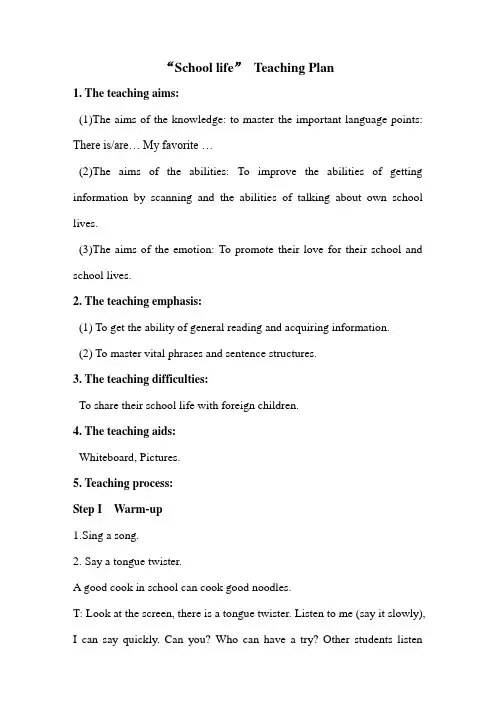
“School life”Teaching Plan1. The teaching aims:(1)The aims of the knowledge: to master the important language points: There is/are… My favorite …(2)The aims of the abilities: To improve the abilities of getting information by scanning and the abilities of talking about own school lives.(3)The aims of the emotion: To promote their love for their school and school lives.2. The teaching emphasis:(1) To get the ability of general reading and acquiring information.(2) To master vital phrases and sentence structures.3. The teaching difficulties:To share their school life with foreign children.4. The teaching aids:Whiteboard, Pictures.5. Teaching process:Step I Warm-up1.Sing a song.2. Say a tongue twister.A good cook in school can cook good noodles.T: Look at the screen, there is a tongue twister. Listen to me (say it slowly), I can say quickly. Can you? Who can have a try? Other students listencarefully, then tell me who is the best one. Let’s say it together. I think everybody is the best one in class. Boys and girls, Are you the best one? 3. Free talkT: You are so lovely, I love you. And I love your school, too. Because there are so many high buildings, friendly teachers and lovely kids. Do you love your school? Why? Is your school the best one in Yichang? Step II Pre-reading1. Show a picture of Tina.T: I have a foreign friend, her name is Tina. She said her school is the best one in the world. Do you have any questions?Ss: What’s in her school?When/how does she go to school?What class does she have?What does she do after class?What’s her favorite lesson/teacher/?…(Let the Ss imagine the answers.)T: Good questions. Look, Tina wrote us a letter to introduce her school life. Would you like to have a look?Step III While-Reading1. Let the Ss watch and listen the letter, then think about 2 questions.1). Where is Tina from?2). Does Tina have fun in school?(Watch and listen the letter, then think about 2 questions. )2. Read the paragraph 1, and think. (T: What’s in her school? What is it like? Take out your letter, read the paragraph 1, circle the answers)1).What can you see in Tina’s school?2).What’s her school like?3. Read paragraph2 then tick or cross: (What class does she have? Let’s read paragraph 2, and then tick or cross.)1) Tina often goes to school on foot. ( )2) Classes begin at 8:00. ( )3) Tina has Chinese class in school. ( )4) Tina has lunch at home. ( )5) Tina joins a music club after school. ( )(T: Read it again and find out the difficult words or sentences. Teach the new words: history, social practice, club… )3. Read the paragraph 3 and 4, try to ask more questions then ask and answer in groups.(T: this group read the paragraph 3, and this group read the paragraph 4, Try to ask more questions.)4. Try to retell the letter (Key words).(T: We know something about Tina’s school life. Her school is….how do you think Tina’s school life? It’s …)Step IV Past-readingLet Ss say something about their school lives in groups of four. Each of them needs to choose a main idea to talk about.1. school and your classroom2. lessons and activities3. your teachers4. your classmates, friends(T: Boys and girls, Tina really wants to know your school life in China, can you introduce for her? You can choose a main idea to talk about.) Step V. Extension1. Ss write down the main idea in groups. ( T: Take out your letter, write to Tina, please.)2. Give a report then make a letter to Tina.(T: Which group can read your letter? Stick your letter on the blackboard. Boys and girls , This is a letter from … to Tina , so we should write …here.)3. T: Your school life is so wonderful and colorful. We wish our school will shine everyday. We wish our school life is more and more colorful and wonderful. Let’s sing the song “our school”.Step VI : Homework Collect the school life of foreign pupils, and tell your classmates.Writing on the blackboardSchool lifeWhat’s…like? b uilding The USA ChinaWhat class… have ? e ducationHow many…? s tudentWhat’s her favorite…? t eacher。
Unit-1-School-Life教案
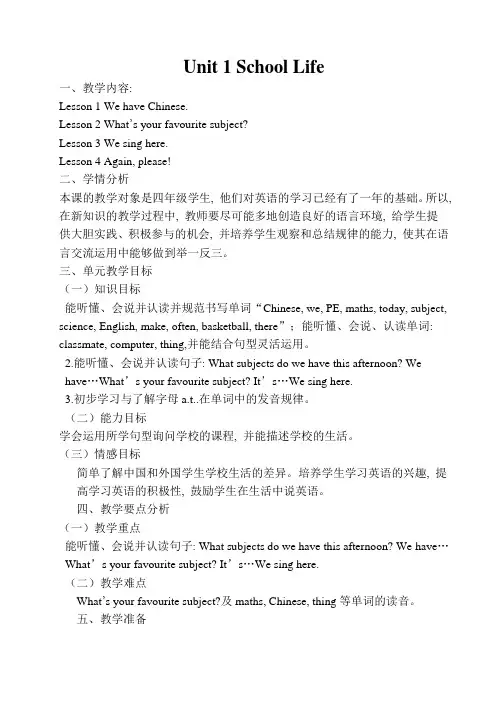
Unit 1 School Life一、教学内容:Lesson 1 We have Chinese.Lesson 2 What’s your favourite subject?Lesson 3 We sing here.Lesson 4 Again, please!二、学情分析本课的教学对象是四年级学生, 他们对英语的学习已经有了一年的基础。
所以, 在新知识的教学过程中, 教师要尽可能多地创造良好的语言环境, 给学生提供大胆实践、积极参与的机会, 并培养学生观察和总结规律的能力, 使其在语言交流运用中能够做到举一反三。
三、单元教学目标(一)知识目标能听懂、会说并认读并规范书写单词“Chinese, we, PE, maths, today, subject, science, English, make, often, basketball, there”;能听懂、会说、认读单词: classmate, computer, thing,并能结合句型灵活运用。
2.能听懂、会说并认读句子: What subjects do we have this afternoon? We have…What’s your favourite subject? It’s…We sing here.3.初步学习与了解字母a.t..在单词中的发音规律。
(二)能力目标学会运用所学句型询问学校的课程, 并能描述学校的生活。
(三)情感目标简单了解中国和外国学生学校生活的差异。
培养学生学习英语的兴趣, 提高学习英语的积极性, 鼓励学生在生活中说英语。
四、教学要点分析(一)教学重点能听懂、会说并认读句子: What subjects do we have this afternoon? We have…What’s your favourite subject? It’s…We sing here.(二)教学难点What’s your favourite subject?及maths, Chinese, thing等单词的读音。
Culture1Schoollife教学设计书.doc
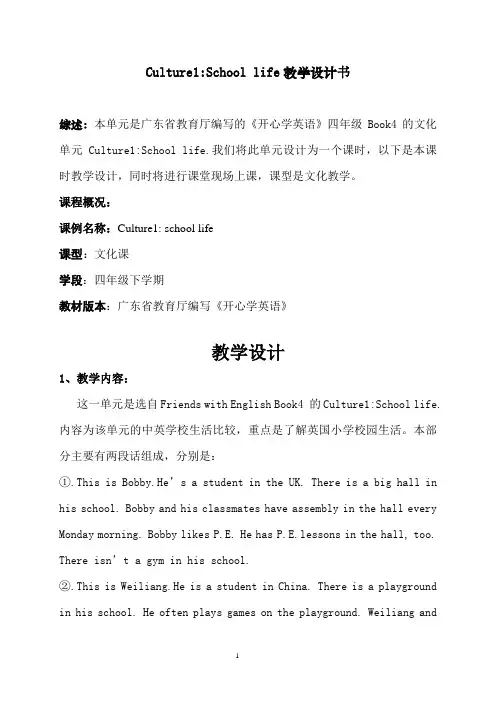
Culture1:School life教学设计书综述:本单元是广东省教育厅编写的《开心学英语》四年级Book4的文化单元 Culture1:School life.我们将此单元设计为一个课时,以下是本课时教学设计,同时将进行课堂现场上课,课型是文化教学。
课程概况:课例名称:Culture1: school life课型:文化课学段:四年级下学期教材版本:广东省教育厅编写《开心学英语》教学设计1、教学内容:这一单元是选自Friends with English Book4 的Culture1:School life.内容为该单元的中英学校生活比较,重点是了解英国小学校园生活。
本部分主要有两段话组成,分别是:①.This is Bobby.He’s a student in the UK. There is a big hall in his school. Bobby and his classmates have assembly in the hall every Monday morning. Bobby likes P.E. He has P.E.lessons in the hall, too. There isn’t a gym in his school.②.This is Weiliang.He is a student in China. There is a playground in his school. He often plays games on the playground. Weiliang andhis classmates have flag-raising ceremony on the playground every Monday morning. They do morning exercise there at 10 a.m.from Monday to Friday.本课时灵活运用以上材料,根据本校自身特点,把Weiliang换成是孩子们熟悉的同班同学李泳航,由他来介绍我们的中国式校园生活。
Module 1 School Life 教学设计(外研版七年级英语必修一教案教学设计)
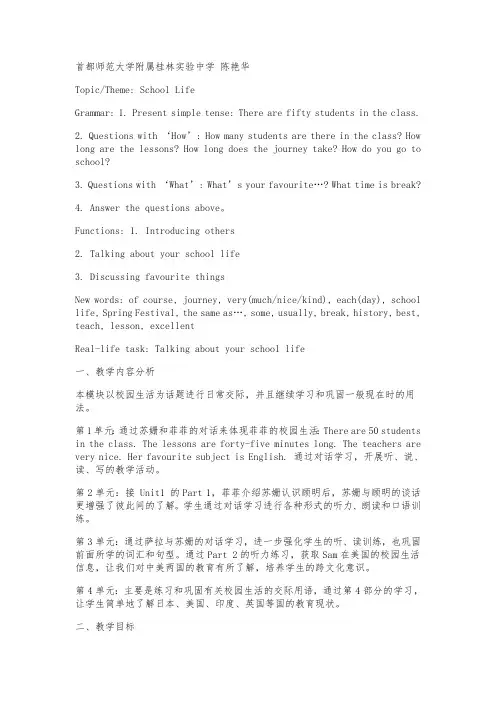
首都师范大学附属桂林实验中学陈艳华Topic/Theme: School LifeGrammar: 1. Present simple tense: There are fifty students in the class.2. Questions with ‘How’: How many students are there in the class? How long are the lessons? How long does the journey take? How do you go to school?3. Questions with ‘What’: What’s your favourite…? What time is break?4. Answer the questions above。
Functions: 1. Introducing others2. Talking about your school life3. Discussing favourite thingsNew words: of course, journey, very(much/nice/kind), each(day), school life, Spring Festival, the same as…, some, usually, break, history, best, teach, lesson, excellentReal-life task: Talking about your school life一、教学内容分析本模块以校园生活为话题进行日常交际,并且继续学习和巩固一般现在时的用法。
第1单元:通过苏姗和菲菲的对话来体现菲菲的校园生活:There are 50 students in the class. The lessons are forty-five minutes long. The teachers are very nice. Her favourite subject is English. 通过对话学习,开展听、说、读、写的教学活动。
Unit1?School?life单元教案
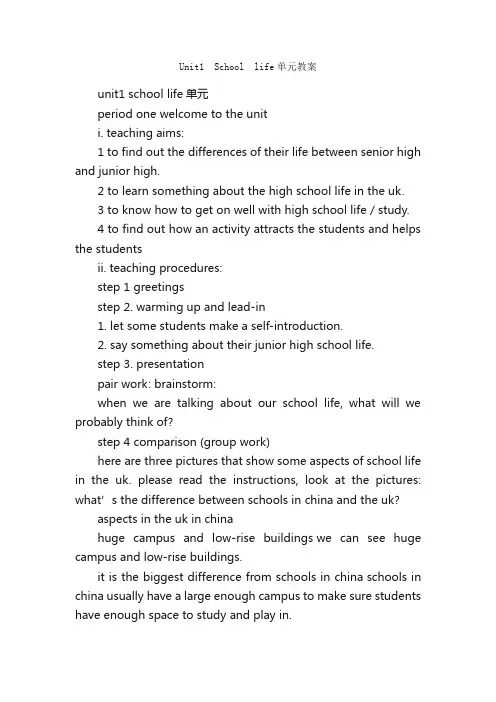
Unit1 School life单元教案unit1 school life单元period one welcome to the uniti. teaching aims:1 to find out the differences of their life between senior high and junior high.2 to learn something about the high school life in the uk.3 to know how to get on well with high school life / study.4 to find out how an activity attracts the students and helps the studentsii. teaching procedures:step 1 greetingsstep 2. warming up and lead-in1. let some students make a self-introduction.2. say something about their junior high school life.step 3. presentationpair work: brainstorm:when we are talking about our school life, what will we probably think of?step 4 comparison (group work)here are three pictures that show some aspects of school life in the uk. please read the instructions, look at the pictures: what’s the difference between schools in china and the uk?aspects in the uk in chinahuge campus and low-rise buildings we can see huge campus and low-rise buildings.it is the biggest difference from schools in china schools in china usually have a large enough campus to make sure students have enough space to study and play in.but most school buildings are taller, at least three storeys.lockers for every student there are rows of lockers by the classrooms for students to put their stationary, books, exercise-books and other belongings. students bring what they need for lessons to school and then take it all back home after school. most schools in china do not have equipment in the classroom.fewer students in each class there are fewer students in a class, no more than 30 per class. there are usually more students in high school, perhaps 40 to 50 per class. recently some school are beginning to limit the number of students in each class.at ease with our teacher students have a close relationship with their teachers. they feel at ease and comfortable with them. it is similar in china. nowadays, lots of teachers and students have established a good relationship with each other. they respect each other and work to gain a better understanding of each other.step 5 discussionl what kind of school activities do you enjoy?2 do you know any further differences between the schools in the uk and china?3 what is your dream school life like?what do you think the teachers should be like?。
Unit1Schoollife全课教案1(牛津版必修一).doc
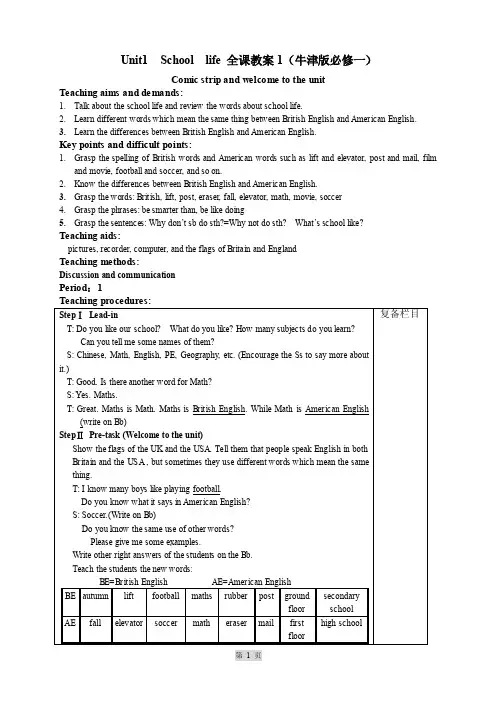
Unit1 School life 全课教案1(牛津版必修一)Comic strip and welcome to the unitTeaching aims and demands:1.Talk about the school life and review the words about school life.2.Learn different words which mean the same thing between British English and American English.3.Learn the differences between British English and American English.Key points and difficult points:1.Grasp the spelling of British words and American words such as lift and elevator, post and mail, filmand movie, football and soccer, and so on.2.Know the differences between British English and American English.3.Grasp the words: British, lift, post, eraser, fall, elevator, math, movie, soccer4.Grasp the phrases: be smarter than, be like doing5.Grasp the sentences: Why don‟t sb do sth?=Why not do sth? What‟s school like?Teaching aids:pictures, recorder, computer, and the flags of Britain and EnglandTeaching methods:Discussion and communicationPeriod:1Reading(1)Teaching aims and demands:1.Know the school lives in British school and American school.2.Learn to read and understand the article with different ways of reading.3.Learn how to understand the writer‟s opinion.Key points and difficult points:1. Know the meanings of the new words: mixed, together, subject, myself, tasty, meal, guy(s), twice, softball, practice, buddy, senior, hero, close, article, admire2. Understand the meanings of the phrases: in Y ear 8=in Grade 8,a mixed school, Home Economics, learn how to do sth, do sth for oneself, cook healthy and tasty meals, bring in, a Reading Week, the end of sth, as well, take a bus, twice a week, spend time doing sth, learn about, help sb with sth, each other, have a great time doing sth.3. Can use this sentence: What does the word …hero‟ mean?It means someone you admire very much.Catch the main information about Lives in a British school and an American schoolTeaching aids: Recorder and computerTeaching methods: Asking and answering questions, communication and discussion Period:2Reading 2Teaching aims and demands:1.Can grasp the words, phrases and language points of the two articles.2. Can retell the lives in a British school and an American school.Key points and difficult points:1. Some important language points.2. Retell the two articles completely.Teaching aids: Recorder, a small blackboardTeaching methods: Explanation and exercisePeriod:3Period:9-4Teaching aims and demands:1.Learn about the school subjects.2.Review and learn the adjective nouns about people‟s opinion.3.Grasp the opposites of the adjective nouns.Key points and difficult points:1. Grasp the new words such as art, geography, language, PE, science, useful, unimportant, useless,unpopular and so on.2. Can give opinion on different school subjects.Teaching aids: Computer and the timetableTeaching methods: Summarize and explanationPeriod:9-4Grammar A&BTeaching aims and demands:pare two things using …more…than‟, …fewer…than‟ and …less…than‟.2. Compare more than two things using …the most‟ for the largest amount and …the fewest‟/ …theleast‟ for the smallest amount.Key points and difficult points:1.How to use …more…than‟, …fewer…than‟ and …less…than‟.2.How to use …the most‟ …the fewest‟ and …the least‟. Teaching aids:Teaching methods: pictures, objects and computer Period:5Grammar C& CheckoutTeaching aims and demands:1.Can make comparisons using …the same as‟ and …different from‟.2.Can make comparisons using …the same…as‟.Key points and difficult points:Grasp the sentences like these: My uniform is the same as Simon‟s uniform.My uniform is different from John‟s uniform.Millie‟s pencil box is the same size as Amy‟s pencil box. Teaching aids: Objects and picturesTeaching methods: Exercise and explanationPeriod:6Teaching procedures:Integrated skills (A)Teaching aims and demands:1.Listen to the conversation and try to collect the information.2.Learn more differences of the school lives between China and foreign countries.3.Review the Grammar we have learned.Key points and difficult points:1.How to collect the information you need from the conversation.2.Grasp the Grammar masterly.Teaching aids: RecorderTeaching methods:Asking and answering questions, discussion, practice Period:7Teaching procedures:Speak up & PronunciationTeaching aims and demands:1.Can talk about different schools.2.Can read the dialogue and the sentences in right intonations.3.Know that we make our voice fall at the end of an affirmative sentence. Know that we make our voice rise at the end of a sentence to show surprise. Key points and difficult points:1.Talk about different schools.2.Showing surprise.Teaching aids: RecorderTeaching methods: Reading and practicingPeriod:8Teaching procedures:Main task Period:9-9Teaching aims and demands:1.Learn how to finish the questionnaire with personal information.2.Learn to make a timetable according to the questionnaire.3.Learn to write …My ideal school‟.Key points and difficult points:1.How to know about what people like and dislike.2.How to write …My ideal school‟.Teaching aids:Recorder and computerTeaching methods:Answering the questions of students‟, explanation and exercise。
Culture1 School life 教学设计书
Culture1:School life教学设计书综述:本单元是广东省教育厅编写的《开心学英语》四年级Book4的文化单元 Culture1:School life.我们将此单元设计为一个课时,以下是本课时教学设计,同时将进行课堂现场上课,课型是文化教学。
课程概况:课例名称:Culture1: school life课型:文化课学段:四年级下学期教材版本:广东省教育厅编写《开心学英语》教学设计1、教学内容:这一单元是选自Friends with English Book4 的Culture1:School life.内容为该单元的中英学校生活比较,重点是了解英国小学校园生活。
本部分主要有两段话组成,分别是:①.This is Bobby.He’s a student in the UK. There is a big hall in his school. Bobby and his classmates have assembly in the hall every Monday morning. Bobby likes P.E. He has P.E.lessons in the hall, too. There isn’t a gym in his school.②.This is Weiliang.He is a student in China. There is a playground in his school. He often plays games on the playground. Weiliang andhis classmates have flag-raising ceremony on the playground every Monday morning. They do morning exercise there at 10 a.m.from Monday to Friday.本课时灵活运用以上材料,根据本校自身特点,把Weiliang换成是孩子们熟悉的同班同学李泳航,由他来介绍我们的中国式校园生活。
Module 1《Unit1 School life》word教学设计教案,DOC
I.单元教学目标The First Period ReadingThe Second Period Function and writingThe Third Period Listening and speakingThe Forth Period Language studyThe Fifth Period Integrating skillsThe Sixth Period WritingUnit 1 School life I. 单元教学目标II. 目标语言Ⅲ. 教材分析与教材重组1. 教材分析本单元以School life为话题,旨在通过单元教学使学生了解英国校园生活的一些基本情况及中英两国校园生活的不同之处;学习并能运用表示校园设施的一些基本词汇;学习定语从句的基本概念及关系代词的用法;能就校园活动的话题展开讨论;能就校园活动情况向班任老师做出报告;学习通知的写法;学会设计以介绍学校俱乐部为主题的海报等。
Welcome to the unit 部分利用四幅图片,分别从(校园风貌、生活设施、课堂教学、师生关系)四个不同的侧面介绍了英国校园生活的有关情况。
该部分还设计了三个讨论话题,引导学生对中英两国校园生活进行比较,并就相关话题发表自己的看法。
Reading部分的短文节选自一份校园杂志。
文章由一位交换留学生所写。
作者通过自己的亲身经历简要地介绍了英国学校生活的一些情况。
文章前后分别设计了五个部分的练习:前两个练习(A、B)要求学生运用本单元介绍的两种基本阅读方法(skimming and scanning)阅读文章,把握文章主旨大意,了解文中明显的细节内容;练习C1通过问题的形式考查学生对文中具体信息的把握程度;C2通过判断正误练习加深学生对阅读材料的理解;D部分为词汇练习,要求学生首先联系上下文猜测所给词汇的含义;然后通过配对练习帮助学生掌握新词的含义和用法;E部分要求学生通过运用所给词汇填空的方式完成一封英国学生写给Wei Hua的信件,以进一步加深学生对阅读内容的理解;练习F设计了两个话题,引导学生对校园生活有关话题展开讨论,以获得对文章深层次的理解。
2013牛津译林版必修一unit1《schoollife》word教案(1).doc
英语:Unitl《School Life》教案(1)(译林牛津版必修1)一.教学内容:Unit 1 School life二.教学目标:掌握阅读技巧skim ming and sea nning掌握Unitl词汇及词性变化三.教学重难点:掌握课文中的重点句型的结构、用法Unit 1 School life(一)词汇woodwork n.木工enjoyable adj.愉快的,快乐的(二)课文重难点1)Going to a British high School for one year was a very enjoyable and exciting experienee for me.动名词做主语,例:Playi ng basketball is an easy job while lear ning En glish is really hard work for me.Collecting stamps is my hobby.我的嗜好是集邮。
2)Britain ——England, Scotland, North Ireland, WelshBritish ---- En glish辨析Britain 与England前者指英国,等同于UK,而England指英格兰,它只是英国的一部分。
(1)n.经验,u.n.He is a teacher full of experie nee.(2)n.经历 c.n.We would like to sit around Marco Polo and listen to his exciting experienees in China. Yao Ming ' s experienee in American will make him become a better player.姚明在美国的经历将使他成为更加优秀的球员。
(3)v.体验to experie nee this differe nt way of lifeto experie nee the beauty of n ature体验自然之美联想1: experieneed adj.an experie need teacher联想2:experiment n.实验【模拟试题】(答题时间:45分钟)一、单项填空1. —Do you mind my here?—No, _____ .A. smoke, a bitB. smoked, a littleC. smok ing, not a bitD. smok ing, not a little2. —How long each other before they ______ married?—For about a year.A. have they known, get.B. had they known, gotC. had they see n, gotD. did they know, get3. If you don ' t go swimming, .A. nor shall IB. so will IC. neither do ID. so do I4. You ' d better leave the windows _____ and the door ________A. ope n, closedB. ope ned, clos ingC. ope ned, closeD. ope n, close5. She looked unhappy because she had made _______ mistakes in the English test.6. The sports meet was put off _______ the rain.7. He likes to eat sugar, but _____ in my opinion. A. too muchB. much tooC. too many8. I wonder ________ the foods he ate were high _______ fat and sugar. A. that, ofB. if, inC. what, forD. but, from9. My family _________ TV when my classmates _______ to see me. A. watched, was coming B. was watch ing, coming C. will watch, comeD. were watch ing, came10. I ' m hunting for a housdc®, bright, comfortable and ________ with a big garden. A. all over B. after allC. above allD. in all、阅读理解A. exceptB. becauseC. whenD. because ofA. two scoresB. scores ofC. two scores ofD. score ofD. many too氐*■dSZhil ♦ IldL 中小学教育资源站(),百万资源免费下载,无须注册!11. If you are in terested in work ing in a hotel, call _____ .A. 435-9201B. 534-7618C. 324-9817D. 357-289712. If you want to get a job as a maths teacher, send you resume to ______A. 237 Rockledge St., Syracuse, NY. 13224.B. 404 Snow Road, Syracuse, NY. 13224C. 500 Park Drive, DeWitt, NY . 13214D. 19 South 8 th ST. NY. 1321413. If you dislike work ing on Sun days, being a ____ should be your best choice.A. cookB. secretaryC. salespers onD. veteri naria n assista nt14. If you want to get a job at _______ , you must have office skills.A. Martin ' s ApparelB. East Side Man ageme ntC. Wales Charter SchoolD. Joh nson Marks Ani mal Hospital【试题答案】一、1-5 CBAAB 6-10 DABDC二、11-14 DDCB。
牛津译林版必修一Unit 1《School life》word教案
Book 1 Unit 1 Word powerTeaching aims:1 Help students be familiar with the names of school facilities2 Help students revise to express how to get some where.3 Get students to be familiar with the sports equipments in the gym.4 To practice students’ speaking ability.Teaching procedures:Step 1 Warming up1.Show a picture of Dong Shan, and ask a question:“Do you enjoy your school life in Dong Shan?”2.Ask some students to answer.Step 2 Vocabulary learning for school facilities1. Show some picture of Dong Shan. Ask students to name the places.(Game: Boys PK girls, to see who can name more facilities)3.Make a list of school facilities and read the words.Step 3 Brainstorm1.Q: If you want to go to the classroom, but you don’t know your way, how canyour way, how can you ask the way?2.Ask students to answer and then make a list:Excuse me, can you tell me the way to…?Excuse me, which is the nearest way to…?…Step 4 Part A&B1.Look at the map and read Wei Hua’s thoughts.1)Try to find out which route she will take, the red one or the blue one.2)Underline the v.+prep. Phrases she used to describe the route.2.Conclusion: Describe positions and directions.1)Here I am at…2)Walking towards…3)Go/walk between…4)Go/walk past…5)Turn left/right…6)Go straight on…7)Then we should see…3.Pair wokAsk students to read the guidelines of Part B, and finish the writing description of the quickest way to get from the dormitories to Classroom 4. Then get each of them to read their passage to their partner. And then ask some of them to read their passage to the whole class.Sample answers:(B) If you are standing at the door of the dormitories, first turn right and go past the medical centre and the gym, then turn left and walk until the end of the road. Classroom is on your left.4. Design some more samples for the students to practice. For example, ask students to mark the shortest way from the science laboratory to classrooms 16-25. This exercise encourages students to familiarize the phrases of finding the way. (If time doesn’t permit, this step can be left out.)5. Ask students to finish Part C individually, and then check the answers with the whole class.Answers:(C) 1 car park 2 classrooms 3 library 4 labs 5 gym 6 swimming pool 7 dormitories 8 medical centre 9 canteenStep 5 Vocabulary extension1. Lead in.Q: For all the school facilities, which one do you like best?Ss: …T: I liked to go the gym most, when I was in my university, I can do sports there and keep fit. There are many kinds of sports equipments in the gym.2. Show a picture of the gym.3. Ask students to read the guidelines of Part D. Then get them to look at the words under the picture and guess the meaning of each word. They can first write down the number of the words of which they know the meanings before these words. Then guide students to guess the meanings of the words they don’t know.Answers:(D) 4 beam 7 barbell 1 climbing bars 6 basketball court 2 rings 8 mat 3 dumb-bell 5 skipping rope2 Ask students to read the words that appear in this part and try to learn them by heart. Step 6 Discussion1.If we will build a new big gym in Dong Shan, what kinds of equipments or courtsshould be included in your opinion?2.Ask students to discussion the above topic in groups, and then ask some of themto show their results.Step 7 Homework1. Let the students to remember all the useful words and expressions in Part A, B, andD .2. Ask the students to make a map of Dong Shan Senior High School.。
- 1、下载文档前请自行甄别文档内容的完整性,平台不提供额外的编辑、内容补充、找答案等附加服务。
- 2、"仅部分预览"的文档,不可在线预览部分如存在完整性等问题,可反馈申请退款(可完整预览的文档不适用该条件!)。
- 3、如文档侵犯您的权益,请联系客服反馈,我们会尽快为您处理(人工客服工作时间:9:00-18:30)。
Culture1:School life教学设计书
综述:本单元是广东省教育厅编写的《开心学英语》四年级Book4的文化单元 Culture1:School life.我们将此单元设计为一个课时,以下是本课时教学设计,同时将进行课堂现场上课,课型是文化教学。
课程概况:
课例名称:Culture1: school life
课型:文化课
学段:四年级下学期
教材版本:广东省教育厅编写《开心学英语》
教学设计
1、教学内容:
这一单元是选自Friends with English Book4 的Culture1:School life.内容为该单元的中英学校生活比较,重点是了解英国小学校园生活。
本部分主要有两段话组成,分别是:
①.This is Bobby.He’s a student in the UK. There is a big hall in his school. Bobby and his classmates have assembly in the hall every Monday morning. Bobby likes P.E. He has P.E.lessons in the hall, too. There isn’t a gym in his school.
②.This is Weiliang.He is a student in China. There is a playground in his school. He often plays games on the playground. Weiliang and
his classmates have flag-raising ceremony on the playground every Monday morning. They do morning exercise there at 10 a.m.from Monday to Friday.
本课时灵活运用以上材料,根据本校自身特点,把Weiliang换成是孩子们熟悉的同班同学李泳航,由他来介绍我们的中国式校园生活。
而Bobby 也换成了Jamie,通过他的短片介绍来了解英国小学校园生活。
2、教学流程图:
3、教学目标:
1. Language skills:
a. Students are able to get the main information about the Chinese school life
through the video and the questionnaire.
b. Students are able to have a better understanding of British school life through the video and the discussion;
2. Language knowledge:
a. Students are able to talk about Chinese school life;
b. Students get to know some differences between Chinese school life and
British school life;
3. Learning Strategies:
a. Students are able to get information through activities;
b. Students are able to distinguish the different lesson periods and activities.
c. Students are able to share the culture differences between the two kinds of
school life.
4. Emotional Effect :
Students develop the motivation to learn more about British school life.
5. Cultural awareness:
a. Students have the awareness of the differences between the British school life
and Chinese school life.
b. Students have intercultural awareness through activities.
4.教学重点和难点:
Teaching key points:
Students know more details on British school life and experience it by finishing
a task in English lesson .
Teaching difficult points:
1.Talk about school life in English
2.Cultural awareness
3.Intercultural awareness
5.教学策略:
●Teaching Method Task-based Language Teaching, Communicative
Language Teaching, the Audio-lingual Method
●Teaching Aids PPT, worksheets
6.教学过程:
7.教学检测安排:
统一在整个单元完成后,进行综合检测。
8.板书设计:
British school life Chinese school life
1.Time to school
2.Flag-raising ceremony
3.The first lesson
4.Lessons in a day
5.Lunch
6.Time for home
7.After school
9.课堂练习:
⑴ Questionnaire: school life in China。
